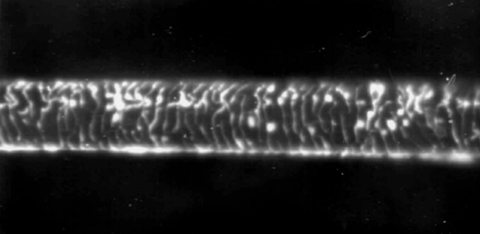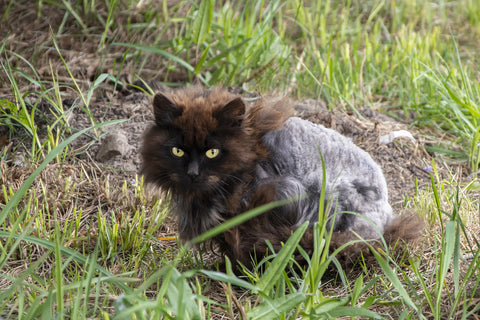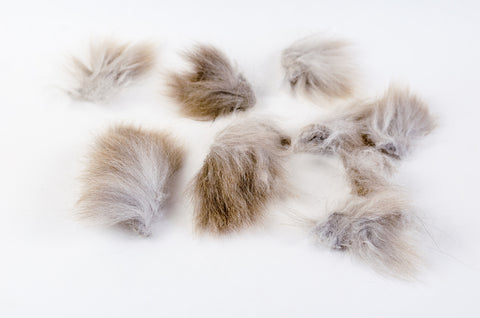What to do about matted cat fur
Ugh. You can feel it…right there in your cat’s armpit, or under her collar, or where her cute little legs swish against each other as she walks.
It’s an itty-bitty mat. Just a tiny knot, really. Nothing serious. You’ll get to it later, you tell yourself. It’s no big deal.
Well, that mat may be tiny now, but it is going to be a big deal to your cat in very short order. It’s better to get to it right away, while it’s easy to manage, and before it causes harm. Or, before it ends up requiring a trip to the groomer or the vet.
Let’s talk about what matted cat fur is, why it’s dangerous, and what you can do about it.
What is a mat in a cat’s fur?
A mat is basically a knot in the fur that has gone haywire, the way a small snowball turns into a boulder as it rolls downhill.
Maybe a tiny bit of leaf got stuck in the fur, tangling a few hairs in its rough edges. Or, maybe the fur was a little oily and a few strands clung to each other.
For whatever reason, your cat didn’t groom well enough to put these wayward hairs back in order. Before you know it, a few more hairs have joined the party, and some bits of dirt, and maybe a little dandruff, too.
A tiny mat can turn into a giant wad of woven fur in no time at all.
How do mats form?
Your cat’s fur may feel silky smooth, but scientists who looked at cat hair under a microscope discovered that it’s “denticulated.”[1]

Like “dentist,” the word “denticulated” is related to teeth. Denticulated means that the cuticle – the outer layer of each individual hair – has little sharp points or teeth on it.
You can sort of see that in this photo of a cat hair under a microscope, that although cat hair feels soft, it’s actually kind of ridged.
Those ridges cause hairs that are next to each other to catch on each other, and tangle, rather than slide harmlessly past each other.
Mats are like felt, or dreadlocks
In the wool industry, sheep fleece is felted, or compacted, by rubbing the fibers together.[2] The results can be beautiful. Check out our felted mice.
For some humans, who wear their hair in the style of dreadlocks, the “locs,” or the rope-like strands of hair, are often formed by deliberate matting.
In the case of cats, the mats are sort of cemented together with accumulated dirt, shed hairs, and dead skin cells.
Why are mats on cats dangerous?
What’s a few knots?
While it might seem like the biggest problem with matted fur is that it isn’t pretty, mats can be much more than a cosmetic problem.
Like felt, the interwoven fur in a mat tends to tighten over time, pulling on the skin. The mats themselves trap dirt, bacteria, and even parasites. (Yuck.)
This combination of tugging, filth, and parasitic creatures, can wreak havoc on a cat’s skin, causing it to bruise, or become thin, fragile, and infected.
Even people with dreadlocks, which have been formed deliberately and carefully by their owners, can cause hair loss and scarring of the scalp from the same root causes: tugging and tension on the hair follicles.[3]
Why do some cats get mats?
Cats are grooming machines. They were positively designed for grooming, from their super-flexible spines that allow them to reach every inch of their being with their tongues, to the cat tongue itself, which is, basically, a living hairbrush.
In fact, grooming too much can be a real problem for some cats. I’ve written a whole blog post about overgrooming, which you can read here.
The bottom line is, that thanks to near-constant grooming, most cats don’t get mats most of the time.
But sometimes a cat can’t keep up, or can’t groom well enough, and a mat forms. Here are some of the reasons cats get mats:
How do you get rid of mats in your cat’s fur?

First decide if the person who should be getting rid of the mats is you.
If there is only one or two mats, you may be able to handle the problem at home. If there are more than two mats, or if the mats are particularly large, or if your cat seems stressed or uncomfortable, seek out the services of a professional groomer.
A professional groomer will work quickly and with confidence to keep the de-matting session as low-stress as possible. Consider hiring a mobile groomer, if one is available where you live. They’ll come right to your front door with a fully equipped van, reducing the amount of time your cat is away from home and feeling stressed.
Before you start removing mats
Before you do anything, ask yourself whether your cat needs to see a vet first.
If the mats in your cat’s fur have developed suddenly, or are uncharacteristic for him, it might be worth getting a professional opinion on the matter. A cat who is unwilling or unable to groom may have a more serious underlying health problem that should be addressed.
What tools do you need?
(*Note: as an Amazon Associate, I may earn from qualifying purchases.)

Don’t go crazy. You’ll mostly need your fingers and maybe a little cornstarch, olive, or coconut oil.
A stainless-steel comb, like this one by Andis, will be helpful, as will a slicker brush with plain pins, like this one by Burt’s Bees.
If the mat is small, and you can see all the way down to the skin, you can consider using an electric clipper. I own an older version of this clipper by Andis, and can recommend it (shh…don’t tell anyone: I used it to cut my husband’s hair during Covid, too), but Oster and Wahl are excellent brands, as well.
Step-by-step guide to removing a mat in a cat’s fur

Whatever you do, take things S-L-O-W. Cat mats are not a problem that is going to be solved in one day. Do a little at a time, and then stop, and wait until tomorrow to continue.
Small mats can often be carefully combed out by hand, but it takes a lot of patience, and usually a helper with a mountain of treats to keep the cat calm and distracted.
- Rub cornstarch, olive oil, or coconut oil into the mat, all the way down to the skin if you can reach it. Work in whatever product you choose gently and slowly with just your fingers.
- Hold the mat in your left hand (if you’re a righty. If you’re a lefty, switch), with your thumb and forefinger at its base. The idea is that if you pull on the mat, you won’t be pulling on the cat’s skin.
- Tease away any loose hair that may have become entangled, but can be easily separated from the mat, so that you get down to the “core” of the mat.
- Working from the outermost edge of the mat, holding a stainless-steel comb in your right hand (left, if you’re a lefty), use just the first 3-4 tines of a stainless-steel comb to try to tease the mat apart. As you make progress, continue moving down the mat, toward the skin.
- Stop and take a break if the cat seems stressed. Or better yet, stop for the day and try again tomorrow. You need a cooperative cat to get the job done, so be patient.
- If your cat is too stressed out by this process, even with just a small mat, she may need to be sedated for the procedure. Contact your vet for help.
What about clippers?

Using clippers is an advanced technique. It’s easy for a cat’s skin wrinkles to get caught up in the teeth of the blade. The matting itself can hide bits of skin that have been lifted into the middle of the mat.
The other problem is that clippers are noisy, and most cats are not going to be instantly fond of that sound. You’ll probably have to work with your cat to acclimate him to the sound of the clippers, which can take some time. (Unless you happen to have a very relaxed, trusting cat.)
If you’re going to try clippers, work on only a tiny area at one time, and only in spots where you can fully see the skin. If the job is going to be more difficult than that, leave it to the professionals.
How to introduce a cat to clippers
- Let the cat sniff the clippers when they are off. Offer treats to a cat who seems interested in the clippers. Leave the clippers around while you go about your life.
- When your cat seems non-plussed by the clippers, turn them on a room away from the cat. Don’t rush to this step. If your cat is still wary of the clippers, leave them out for another day or more in the off position.
- Feed treats when the clippers are on, even if you can barely hear them (I’m sure your cat can hear them just fine). If the cat ever appears fearful, turn the clippers off and move them even further away before turning them on again.
- Gradually, over time, bring the clippers closer to the cat, offering treats so long as she remains relaxed. Take this really slow. Maybe one day in the clippers are on in the basement. Maybe the next day the clippers are on in the kitchen, while your cat is in an upstairs bedroom.
- If your cat looks nervous, don’t offer treats; just move the clippers far enough away so that she relaxes again.
- Eventually, you should be able to run the clippers near your cat without frightening him.
How to use clippers to remove a mat
- Shave in the direction of the fur. In other words, if you are shaving a mat on your cat’s back, start on the head-side of the mat and work towards the tail-side of the mat.
- You do not need to go all the way down to the skin if the mat is more superficial. Only go down far enough to remove the mat.
- To remove a mat, hold the mat with one hand and gently pull it away from the skin. Gently slide the clippers under the mat, keeping the flat blade parallel to the mat.
- Take plenty of breaks and treat, treat, treat that good kitty!!
If you find an open wound, fleas, or other parasites, consult your veterinarian. Note that if the skin is sore or sensitive, a cat can make it worse by licking the spot. She may need to wear an e-collar or onesie to prevent a hot spot from developing.
(Read this post on fleas if you need to learn how to get rid of them.)
What should you never do when trying to get a mat out?
What can you do to prevent mats from forming?
When it comes to mats, an ounce of prevention is definitely worth a pound of cure. With a little effort, you can probably prevent most mats from ever forming.
Love Pinterest? Here's a Pinterest-friendly pin for your boards!

Dawn LaFontaine
Dawn LaFontaine is a lifelong animal lover who always seems to have a little pet hair in her keyboard. Her blog, Kitty Contemplations, helps cat guardians better understand and care for the special beings they share their lives and homes with. Her cat-products business, Cat in the Box, sells beautiful, well-made, and award-winning products that she designed to meet the biological needs of cats.
_______________
FOOTNOTES
[1] Cyto-Morphological Particularities of the Hair Cuticle in Canidae and Felidae Families - Scientific Figure on ResearchGate. Available from: https://www.researchgate.net/figure/Hair-cuticle-in-domestic-cat-Felis-catus-sp-Microphoto-200x_fig2_285523002 [accessed 21 Sep, 2023] https://www.researchgate.net/figure/Hair-cuticle-in-domestic-cat-Felis-catus-sp-Microphoto-200x_fig2_285523002
[2] “Acute Hair Matting.” DermNet, dermnetnz.org/topics/acute-hair-matting. Accessed 21 Sept. 2023.
[3] Team, Zenore. “Do Braids and Dreadlocks Create a Receding/Thinning Hairline?” ZENORE, 16 Feb. 2022, zenorehaircare.com/blogs/the-handbook/do-braids-and-dreadlocks-create-a-receding-thinning-hairline.
[4] Better Not Younger. “What Does Humidity Do to Hair? (Solved).” Better Not Younger, better-notyounger.com/blogs/the-better-blog/how-humidity-affects-different-hair-types. Accessed 21 Sept. 2023.
[5] “Hyperthyroidism in Cats.” Cornell University College of Veterinary Medicine, 21 June 2023, www.vet.cornell.edu/departments-centers-and-institutes/cornell-feline-health-center/health-information/feline-health-topics/hyperthyroidism-cats.
[6]“Seborrhea in Cats: VCA Animal Hospital: VCA Animal Hospitals.” Vca, vcahospitals.com/know-your-pet/seborrhea-in-cats. Accessed 3 Oct. 2023.
[7] “Seborrhea in Cats: VCA Animal Hospital: VCA Animal Hospitals.
[8] Salapatek, Lauren. “Getting to the Root of Matted/Tangled Hair.” Modern Salon, Modern Salon, 11 July 2011, www.modernsalon.com/359708/getting-to-the-root-of-matted-tangled-hair.

